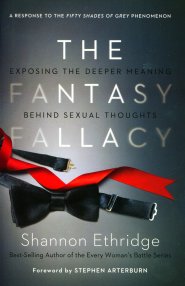In Reponse to 50 Shades of Grey
In ‘The Fantasy Fallacy’, Shannon Ethrirdge has created an essential academically reliable, biblically sound and spiritually protective work in response to the potentially damaging effects of ‘Fifty Shades of Grey’.
"Hopefully," she prays, "This will usher in an even BIGGER tidal wave of (healthy) sexual curiosity, than Fifty Shades of Grey!" Taking the topics raised in the secular book, and thinking about how Christians should respond to sex and dominance in relationships, bestselling relationships author, Shannon Etheridge, tackles the issues head on with a sound biblical approach and without skirting around the difficult issues.
With so much talk about this ‘Fifty Shades of Grey’, Shannon is keen to promote a pastoral, biblical informed response supported by facts and real life accounts. Taking God's design for sex and relationships and comparing it to the relationships in ‘Fifty Shades of Grey’ make this book an essential tool for those in ministry and those wishing to engage with the issues seriously. If you’re involved in dealing with the fall out from Fifty Shades among the vulnerable or young, this book was written with you in mind.
EDEN ARTICLE: WHAT
Describing her hopes for ‘The Fantasy Fallacy’ Shannon says that wanted the book to be psychologically sound, but biblically-based. Her professor at Liberty University, Dr. Tim Clinton, president of American Association of Christian Counsellors taught her that Satan had distorted God’s gift of sexuality even before the end of the book of Genesis, introducing corrupting and hurtful behaviours. To try and understand the psychological reasons for these temptations, she researched:
- How many people have sexual fantasies that don’t match their moral values?
- How common is it to fantasise about a co-worker or a friend’s partner?
- How many fantasise about having a same-sex partner even though they’re heterosexual?
- Why might a man may fantasise about raping a woman?
- Why might a woman may fantasize about being raped?
- What happens in the brain when a man or woman experiences orgasm?
- How exactly do our thoughts trigger (or block) that process?
- Can unwanted fantasies be avoided, or re-constructed in keeping with your values?
Overwhelmed by information collected, she designated a big wall as a “story board” and literally pieced the work together with scissors and tape. Mapping everything out was probably enabled her to formulate an outline of what she wanted to say in the book and create the table of contents:
CONTENTS:
1. Why Discuss Sexual Fantasies?
2. The Benefits of Boundaries
3. The Faces Behind Sexual Fantasies
4. Pornography: The Fantasy Factory
5. Bartering with Our Bodies
6. When “One Flesh” Isn’t Enough Flesh
7. Grappling with Gay and Lesbian Fantasies
8. Our Fascination with Pleasure, Pain, and Power
9. Putting Fantasy in its Place
Into the hard facts and evidence, she wove personal stories and powerful testimonies about how people learned to understand the root of their own fantasies, and overcome the guilt, shame, and negative impact of them. So after every chapter, there are “Behind the Curtain” features that highlight these stories and help readers see how to apply the principles covered throughout the book, vividly demonstrating how to control damaging sexual fantasies, rather than allowing them to control and damage us. – Les Ellison
Trustpilot








